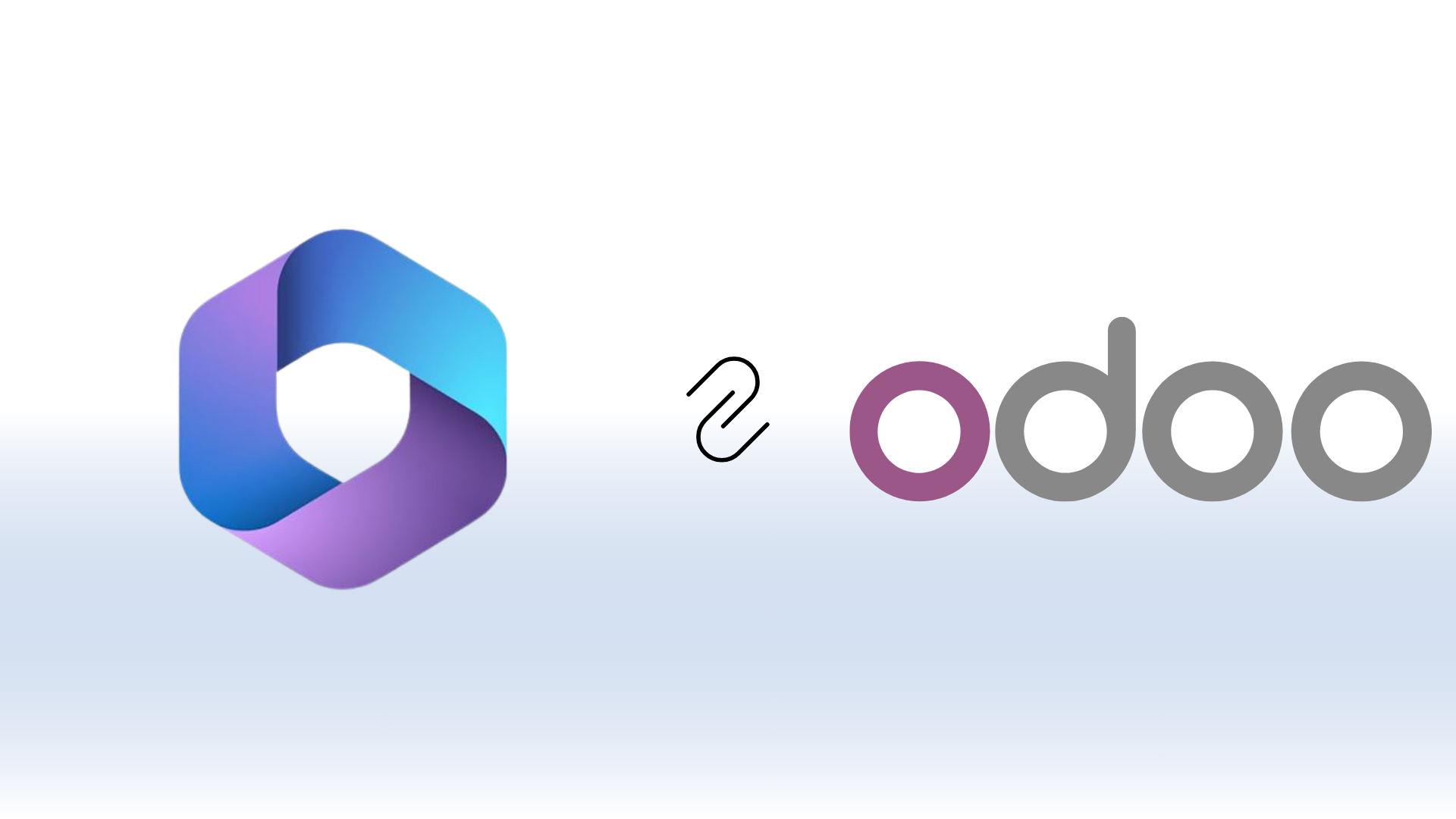In today's increasingly digital landscape, businesses need not only a flexible ERP system but also modern office tools to optimize work efficiency. Odoo, a comprehensive business management platform, combined with Microsoft 365, the world's leading productivity suite, creates a synchronized, intelligent, and highly optimized ecosystem.
This integration centralizes data, enables seamless collaboration, and delivers a significant competitive edge by saving time, reducing operational costs, accelerating decision-making, and boosting overall work performance. This is the key for SMEs to unleash their full potential and thrive in the current volatile business environment.
1. Overview of Odoo and Microsoft 365

Odoo is a comprehensive ERP (Enterprise Resource Planning) system designed to support businesses of all sizes. With over 30 core applications like CRM, Sales, Inventory, Accounting, and HRM, Odoo helps businesses manage everything from sales and inventory to accounting and HR in one centralized location. Odoo's key strengths lie in its flexible customization and phased implementation, allowing businesses to scale up according to their real-world needs without having to replace the entire system.
Meanwhile, Microsoft 365 is a leading productivity suite that is familiar to most businesses worldwide. This solution includes Outlook, Teams, Excel, OneDrive, and SharePoint, all of which help optimize day-to-day work. While Odoo focuses on management and operations, Microsoft 365 excels at collaboration, communication, and document management. This allows employees to work anytime, anywhere, and connect quickly, all while ensuring data security on the cloud.
It's clear that Odoo and Microsoft 365 have distinct strengths that perfectly complement each other. By integrating them, businesses not only get a powerful ERP system for comprehensive management but also leverage the superior collaboration capabilities of Microsoft 365, creating an intelligent, unified, and highly efficient work environment.
2. Why integrate Odoo with Microsoft 365?

Integrating Odoo with Microsoft 365 can significantly streamline your business operations and improve internal collaboration. Here's a breakdown of the key benefits:
Enhance internal collaboration
Microsoft 365 excels in collaboration tools like Outlook, Teams, and SharePoint, while Odoo focuses on process management. When these two systems are connected, employees can manage projects in Odoo while communicating directly in Teams or checking schedules on Outlook. This reduces interruptions and boosts team productivity.
Save time and reduce costs
Integration eliminates many manual tasks, such as entering customer data from emails into the CRM or exporting reports from Odoo to Excel. By automating these processes, your team saves valuable time and resources, minimizes errors, and reduces overall operational costs for your business.
Support fast and accurate decision-making
Data synchronized from Odoo can be directly analyzed using Power BI, Microsoft 365's powerful analytics tool. This gives leadership a comprehensive, real-time view of business performance, enabling them to make faster and more accurate decisions.
Gain a competitive advantage
In today's fast-paced digital transformation, businesses with streamlined management systems and effective collaboration have a significant competitive edge. Integrating Odoo and Microsoft 365 is a strategic move that helps small and medium-sized enterprises (SMEs) flexibly adapt to new business models, from e-commerce to the platform economy.
Centralized and convenient document management
- Sync SharePoint/OneDrive with Odoo: Users can store, share, and access documents directly within Odoo while still leveraging Microsoft 365's file management capabilities.
- Online Collaboration: Documents (Word, Excel, PowerPoint) can be edited directly from Odoo using Microsoft Office Online, allowing teams to work on the same file without creating duplicates.
- Easy Search and Access Control: Odoo manages the process, and Microsoft 365 handles storage and permissions, providing better security and control.
Improve financial management
- Excel and Odoo Integration: Financial data from Odoo (invoices, reports, expenses, revenue) can be exported and updated directly in Excel for advanced analysis.
- Dynamic Reporting: Create financial reports, payroll, and budgets using Power BI or Excel Pivot Tables with Odoo data for better visualization and decision-making.
- Process Automation: Email notifications for invoices, payment schedules, or contracts can be synchronized with Outlook Calendar and Teams to improve accounts receivable and cash flow management.
Boost productivity and collaboration
- Outlook + Odoo CRM: Customer emails from Outlook are automatically logged into the Odoo CRM, reducing manual data entry.
- Microsoft Teams + Odoo Projects: Discussions in Teams can be directly linked to tasks in Odoo, ensuring no information is lost.
- Single Sign-On (SSO): Users only need one Microsoft account to access both Odoo and Microsoft 365, which enhances security and simplifies access.
3. Key features of Odoo and Microsoft 365 ntegration
- Email and Calendar Sync: Integration connects Outlook directly with Odoo Calendar and CRM. Customer emails are saved in the CRM, and appointments from Outlook appear on Odoo. This helps businesses manage customer information seamlessly, avoid missing important meetings or tasks, and save employees' time.
- Smart Document Management with OneDrive and SharePoint: When connected with OneDrive and SharePoint, Odoo Documents becomes a centralized hub for contracts, quotes, invoices, and other important files. Users can easily share documents internally or with partners and set detailed permissions to ensure data security.
- Internal Collaboration via Microsoft Teams: Odoo can link to Microsoft Teams to create direct communication channels for each project or customer. Employees can discuss, share documents, and update progress within Teams without leaving the Odoo system. This feature is especially useful for hybrid work models or teams distributed across different locations.
- Data Analysis with Power BI: Data from Odoo—including sales, accounting, inventory, and human resources—can be synchronized with Power BI. This allows businesses to build intuitive reports, track business performance in real time, and make data-driven decisions rather than relying on intuition. This is a crucial tool for leadership to grasp the situation and formulate timely strategies.
4. How to Implement the Integration
Step 1: Analyze Your Business Needs
Before you begin, your company needs to assess its current management systems and tools. A thorough needs analysis will help you identify existing limitations and select the right integration solution. This prevents wasted resources and ensures the new system effectively solves your specific problems.
Step 2: Choose the Right Odoo Modules and Microsoft 365 Services
Odoo offers various modules like CRM, Sales, Inventory, Accounting, and HRM, while Microsoft 365 includes Outlook, Teams, Excel, OneDrive, and SharePoint. Instead of implementing everything at once, you should select only the most essential features for integration. This phased approach helps you save on costs and allows for easy expansion as your needs grow.
Step 3: Connect and Sync Data
Once the scope of the integration is defined, the next step is to connect the systems. This phase focuses on data synchronization between Odoo and Microsoft 365, ensuring information from your CRM, emails, calendars, documents, and reports is consistent and accurate. Proper synchronization prevents data discrepancies and improves the precision of your management processes.
Step 4: Train Staff and Test the System
An integrated system is only effective when your employees know how to use it proficiently. You need to organize training to help your staff understand how to operate the new system, allowing them to fully leverage the features of both Odoo and Microsoft 365. Additionally, testing the system after deployment is crucial for finding and fixing errors, refining workflows, and optimizing performance before the official launch.
Key Notes for a Highly Effective Implementation
For a successful integration, your company must create a clear roadmap that includes both your technical department and end-users. Choosing a reliable implementation partner is also very important to ensure a smooth connection process and timely support when needed. Finally, you should implement the system in stages rather than all at once. This makes the system easier to control and reduces risk.
5. Conclusion
Integrating Odoo with Microsoft 365 provides businesses with a comprehensive management and collaboration ecosystem. From seamless data synchronization and optimized workflows to enhanced work performance and support for quick, accurate decision-making, this solution helps SMEs boost their competitiveness and break new ground in the digital transformation era.
In today's increasingly fierce business environment, adopting smart integration technology is not just a trend—it's a survival strategy. Businesses should start implementing Odoo and Microsoft 365 today to build a modern management platform, maximize business efficiency, and work toward sustainable development. Contact us for a free consultation and to receive materials on our latest technology solutions!